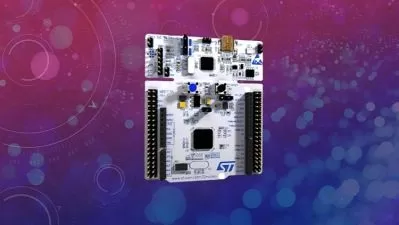Microchip PIC32CM MC microcontroller for power electronics
Shivkumar Iyer
15:40:20
Description
Examples for power electronics applications using the Curiosity Nano Evaluation Kit
What You'll Learn?
- Architecture of the PIC32CM1216MC00032 microcontroller
- Installing MPLAB X IDE and other SDK
- Understanding project setup and libraries
- Overview of the peripherals used in power electronics applications
- Using GPIO pins through the PORT peripheral
- Configuring and setting up interrupts and Interrupt Service Routines (ISR)
- Using timers through the Timer Counter (TC) module
- Generating PWM pulses through the Timer Counter for Control (TCC) module
- Using the Analog to Digital Converter (ADC) for measured signals and control implementation
- Using the Event System Module
Who is this for?
What You Need to Know?
More details
DescriptionThe course will describe how to use the PIC32CM1216MC00032 microcontroller from Microchip for power electronics applications. The PIC32CM MC microcontroller is a very popular low-cost microcontroller used in the power industry for various applications such as motor control and power factor correction. The purpose of this course is to provide young engineers with exposure to microcontrollers used in industry, and help them land their first jobs as power electronics engineers or firmware engineers. The course can also be used as training material by companies to train their engineers in using PIC32 microcontrollers from Microchip. The course covers both theory and programming, with details on the architecture of the microcontroller and its peripherals, as well as code sessions where projects are built from the ground up. The projects are accompanied by experiments with the results being observable either through blinking LEDs or through waveforms on the oscilloscope.
The course describes how students can setup a low-cost electronics lab with components available from online marketplaces. The microcontroller kit (Curiosity Nano Evaluation Kit) needed for the course is readily available in many online marketplaces and costs merely USD 16. The course will begin with very simple examples such as how to make LEDs glow and flash. The course will then progress towards generating Pulse Width Modulation (PWM) gating signals and using the Analog to Digital Converter (ADC) for closed-loop control. The course will use the MPLAB X IDE and the MPLAB XC32 compiler provided for free by Microchip, and also example projects and starter files available on the Microchip website and GitHub page. The course will describe how necessary software can be downloaded and how the student can interpret and understand the example projects.
Who this course is for:
- Undergraduate students in electrical engineering
- Early level graduate students in electrical engineering
- Firmware and test engineers
The course will describe how to use the PIC32CM1216MC00032 microcontroller from Microchip for power electronics applications. The PIC32CM MC microcontroller is a very popular low-cost microcontroller used in the power industry for various applications such as motor control and power factor correction. The purpose of this course is to provide young engineers with exposure to microcontrollers used in industry, and help them land their first jobs as power electronics engineers or firmware engineers. The course can also be used as training material by companies to train their engineers in using PIC32 microcontrollers from Microchip. The course covers both theory and programming, with details on the architecture of the microcontroller and its peripherals, as well as code sessions where projects are built from the ground up. The projects are accompanied by experiments with the results being observable either through blinking LEDs or through waveforms on the oscilloscope.
The course describes how students can setup a low-cost electronics lab with components available from online marketplaces. The microcontroller kit (Curiosity Nano Evaluation Kit) needed for the course is readily available in many online marketplaces and costs merely USD 16. The course will begin with very simple examples such as how to make LEDs glow and flash. The course will then progress towards generating Pulse Width Modulation (PWM) gating signals and using the Analog to Digital Converter (ADC) for closed-loop control. The course will use the MPLAB X IDE and the MPLAB XC32 compiler provided for free by Microchip, and also example projects and starter files available on the Microchip website and GitHub page. The course will describe how necessary software can be downloaded and how the student can interpret and understand the example projects.
Who this course is for:
- Undergraduate students in electrical engineering
- Early level graduate students in electrical engineering
- Firmware and test engineers
User Reviews
Rating
Shivkumar Iyer
Instructor's Courses
Udemy
View courses Udemy- language english
- Training sessions 101
- duration 15:40:20
- Release Date 2024/12/21










